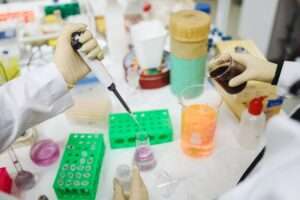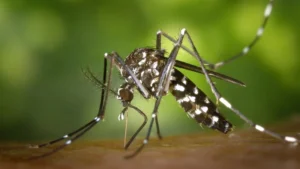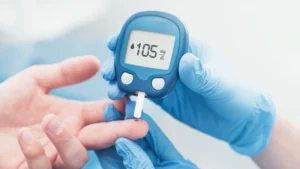Cancer is defined as the uncontrolled growth of cells. These cells can belong to any part of the body but here we are going to discuss prostate cancer. First of all, we have to know what is the prostate? The prostate is a gland located below the bladder in the abdominal cavity. It is a small walnut-shaped gland that produces chemicals responsible for the bath of sperm along with seminal vesicles during ejaculation. So, prostate cancer is the uncontrolled growth of the prostate gland but if it spreads to the other organ like lymph nodes, it is called prostate cancer metastasis. This disease only affects males as the prostate is part of the male reproductive system. The prostate gland surrounds the urethra (a tube that takes the urine from the urinary bladder to the penis). That’s why patients with prostate cancer may feel difficulty in urination as its growth presses the urethra and blocks it.

The most common type of prostate cancer is adenocarcinoma which involved the glandular portion of the prostate. Other types are very rare that are small cell carcinoma, neuroendocrine, transitional cell, and sarcoma. Usually, prostate cancer develops slowly and has no symptoms at the early stages. The severity of the disease depends upon the condition of the infection. Sometimes cancer is benign and just the little bit of growth of cells remains the same during the remaining whole life of a patient. This type is not so dangerous and may not be the cause of death of a patient. But on the other hand, this growth converts into the malignant stage, which is very dangerous and lethal for patients. Its severity can be better understood from the stats that it is the 4th leading cause of cancer death in the US. According to the survey, 34500 men died due to prostate cancer in the US in 2022. Another survey was conducted and predicted new cases of prostate cancer in the US. It was estimated that 268490 men would develop prostate cancer in the year 2022.
The cancer cells might be localized to the prostate and they might travel to the other parts of the body and may cause problems there also like lymph nodes and bones and this is called prostate cancer metastasis.
Signs and Symptoms of Disease
Most of the time in prostate cancer early signs do not appear and in benign tumors as well. But in malignant tumors and late stages, there are following symptoms appear.
- Pain in the lower pelvic region
- Obstruction during the urination
- Painful ejaculation
- Loss of appetite
- Loss of weight
- Pain in the bones
- Anemia (deficiency of RBCs)
- Paralysis

Causes or Etiologic factors
There is no leading causative agent to be mentioned till now. We can enlist certain risk factors which are found to be responsible for disease during the research.
Risk Factors
- Age: the risks of disease are higher in individuals aged above 50 years. The possible explanation may be the damage to the DNA of the prostate with increased age. At older ages, the risks of faulty replication of DNA increase which leads to cancer development. In research conducted in 2018 in the US, it was found that 30 percent of respondents conducted PSA (Prostate-specific antigen) tests to screen for cancer aged 50-64 years.
- Ethnicity: in research, it was found that ethnicity plays important role in the chances of cancer development. African men have more chances to develop prostate cancer as compared to other regions of the world. It may be related to some genetic character but it is not yet clear. Research shows that only 30% of Asian men had prostate cancer compared to 37% of African Americans.
- History: A person having a family history of cancer has more chances than those having no family history.
- Diet: Diet may play important role in the risk factors of cancer development. It was found that obesity may cause prostate cancer. Obesity may be caused due to lack of exercise, food having high calories, and unhealthy and fatty food. High calcium levels may also cause prostate cancer. Low vitamin D can also be a factor in cancer development.
- Any other reproductive Infections may act as a risk factor.

Ejaculation and Prostate Cancer
Commonly it is hypothesized that a high frequency of ejaculation may cause prostate cancer. To rectify this hypothesis, a lot of research was conducted which included a large number of respondents taking their feedback during a specific period about their family life and possible prostate cancer. Studies find that there is no such association present. Instead, a high frequency of ejaculation in older ages reduces the chances of prostate cancer.
Diagnosis
There are a lot of diagnostic tools to detect possible cancer. The most commonly used blood test is:

- In prostate cancer PSA (prostate-specific antigen) detects the specific antigen which proves cancer.
- Digital rectal examination (DRE) is another scan that can tell us about the presence of cancer. But in these tests chances of errors are high. So for more confirmation, other techniques are also being used which include:
- Prostate biopsy is the technique in which a probe is inserted through the anus and firstly size and other physical parameters are observed. After the initial examination, the prostate gland is anesthetized and a small piece is cut and taken out for further laboratory testing and examinations. After keen observation pathologist makes the report regarding the presence or absence of prostate cancer.
- CT scan is conducted to diagnose cancer.
- MRI (magnetic resonance imaging) scan is conducted to diagnose the disease.

The Outcome (Scope of survival)
Most of the time it was found after testing that individuals have prostate cancer but have no symptoms and cause no serious problems to their health during their remaining life. But, the severity of the disease depends upon the test results.
Treatment
Treatments for prostate cancer include:
- Chemotherapy: In this treatment antiviral chemicals are injected into the body during a specific period. During this time chemicals affect the cancerous cells and kill them. Research conducted in 2019, found that 11% of males in the US selected chemotherapy as treatment for their prostate cancer.
- Radiotherapy: In prostate cancer treatment is done through Radiations that are directed at the infected cells to kill them.
- Immunotherapy: medications are given to the patient to boost their immune system. A strong immune system will better fight prostate cancer as compared to external medications.
- Hormonal therapy: Prostate cancer is also treated with hormones.
- Ligand Inhibitors: these are the chemicals that intercept the normal physiological activity of the immune system to inhibit the tumor.
- Prostate Cancer Brachytherapy: This is a type of internal radiation therapy. In this technique capsule containing radiation is placed near the infected organ.
The research was conducted in the US between 2000 and 2019 to find out the change in the percentage of the cause of death. They concluded that the number of deaths caused by prostate cancer increased by 1.8% during this period.
To learn more about interesting articles visit Expert opinionz.







